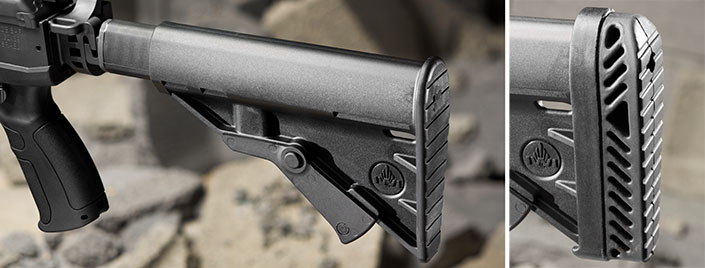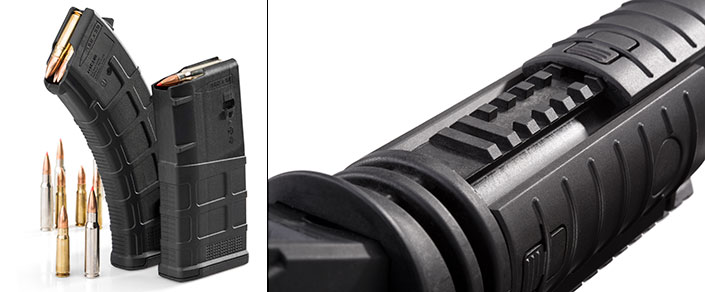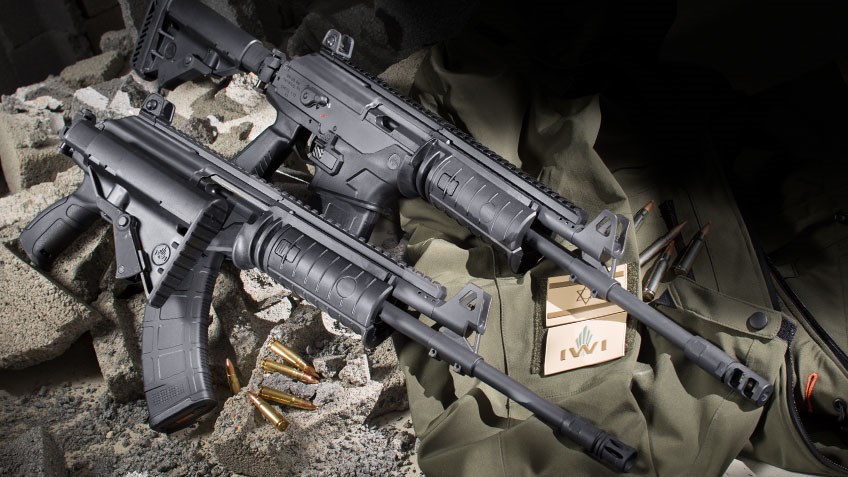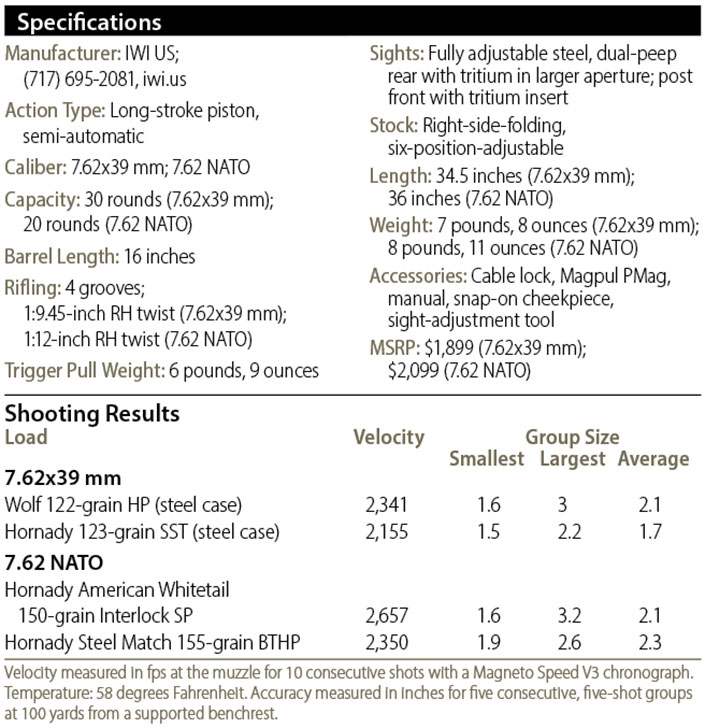Not only is the Galil ACE an updated version of the AK-platform rifles, it’s an updated version of itself. And one very capable rifle series. Read the full review…
SOURCE: NRA: Shooting Illustrated, originally by Steve Adelmann
As a young gun enthusiast, I did’t pay much attention to the Kalishnikov family of firearms. That wasn’t due to any bad experiences with AKs, but rather because I had no experience with them whatsoever. In those days, when the Vietnam War was still a fresh memory that our parents were trying to forget, the Kalashnikovs were either disdained or ignored all together by my shooting influences. There were no commercially-available AK-based variants available here in the U.S. until the Finnish-made Valmet M62S, first imported as a legal-to-own rifle in 1970, and thereafter the Egyptian-made Steyr/Maadi.
The Valmet, like the IWI Galil line reviewed here, improved and updated the basic AK design. The Valmet provided such upgrades as buttstocks better suited to larger-statured people, synthetic furniture, and good iron sights. I read everything I could find on the M62, which wasn’t much in those pre-internet days, but the search nonetheless led me to the Israeli-made Galil family of firearms. Here was a design that incorporated the best of the AK and Valmet features in one platform. Most commonly chambered in 5.56 NATO and carried in near-daily conflict by Israeli troops, the Galil made frequent appearances in my adolescent daydreams.
Most mid-20th-century fighting-rifle designs that have endured into the new millennium have also been upgraded to meet evolving needs. The modern Galil is no exception. It comes to us now as the ACE platform, courtesy of Israel Weapon Industries (IWI). The Galil ACE is offered in two pistol and two rifle configurations. Both pistols are chambered in 7.62x39mm and use 8.3-inch barrels. The only discernible difference between them is that one model has a stabilizing brace and the other does not. One rifle is likewise chambered for the Russian cartridge, while the other is designed around the longer 7.62 NATO. IWI’s U.S. product literature also shows new-for-2017 pistol models chambered in 7.62 NATO and a 20-inch 7.62×39 mm. Several 5.56 NATO models were also introduced at the SHOT Show in January. All Galil ACE models carry the same improvements over the old Galil models like a smaller (left-side) charging handle, reduced iron-sight profiles, magazine commonality with other popular platforms, and integral Picatinny rail mounting surfaces.

One important note: all members of the Galil ACE rifle family are assembled in the U.S. from a combination of American-made and imported parts to stay in compliance with 18 USC§922(r).
I recently tested two Galil ACE rifles, and in spite of their different chamberings and receiver sizes, these modern Galil incarnations share many common features. The ACE’s reciprocating charging handle is manipulated through an easy-to-grab knob protruding through the receiver’s left side. A spring-loaded cover plate positioned below the charging handle’s slot moves down and out of the way as the handle moves rearward, then closes up to protect internal parts as the bolt moves back into battery. A polymer pistol grip that’s molded into a larger plastic section that is attached to the receiver does not appear to be interchangeable with either AR or AK aftermarket parts.

Right-side-folding stocks have the added ability to extend or collapse to any of six positions. Each rifle includes a polymer cheek piece that snaps over the buttstock for use with high-mounted optics. The rest can be attached in one of two positions on the stock to better fit the shooter.

The ACE’s forend has a very stout, aluminum, assembly that provides rails at the 3-, 6- and 9-o’clock positions. Each section is protected by a textured, sliding cover. The 6-o’clock cover has a slight bump at the front edge that should function as a sort of handstop for the pistol variants. Recesses are milled into the front of each aluminum rail section to allow pressure switches and cables to be inset into the forend; covers can then be reattached while providing access to the accessory buttons beneath them. The outer diameter of the fore-end with rail covers attached is a tad wide for my liking at 2.3 inches. The bare-aluminum rails are pretty tough on skin, and a set of silicone, aftermarket covers would be wise addition.

Milled-steel receivers and stamped-steel gas cylinders are topped by linked sections of Picatinny rail. The gas cylinder’s bottom surface slides into receiver slots, but it still has some play when fully seated. Thanks to a stout return spring, the receiver cover is held under enough tension to keep it (and the rail attached to it) very snug. A set of robust iron sights are protected by steel ears on each of the ACEs I tested. A massive front-sight post is easy to spot through either of the rear apertures, and the larger hole and front post come standard with tritium inserts. An included sight-adjustment tool moves the rear sight for windage and the front sight for elevation ala those of the AR family (a bullet tip will work, too). Front sight housings are transverse pinned to dovetails in the barrel and double as gas blocks (also AR-style). They are positioned at the front end of each rifle’s handguard and provide seats for the gas cylinders to mate with.
There are multiple sling-attachment loops, including one on the left side of the folding stock hinge. The right-side folder covers the selector on that side when fully closed, which is right where it stays until needed. The stock quickly deploys into a rock-solid extended position.
Internally, the Galil ACE rifles are very much AK-like in basic design. The long-stroke piston’s chrome-plated operating rod is affixed to the bolt carrier and the bolt itself is assembled into the carrier just like the rest of the AK family. Likewise, the trigger and hammer assemblies appear to be quite Kalashnikovian in design. Both test ACEs had very long trigger pulls that stacked up quickly to the 6-pound, 9-ounce average measured on both rifles.
A small selector lever is present on the receiver’s right side in the familiar Galil location. This lever is positioned so that a right-handed shooter can actuate it with the right forefinger. We lefties are out of luck on that side, but the ACE’s left-side selector was retained from the older model Galils. The positioning just above the pistol grip is best-situated for righties, but a left-handed shooter can either bring the firing thumb over to the left side or use the trigger finger to manipulate the selector. Neither technique is great, but proficiency is possible with practice. Still, a more ambidextrous design would be nice to see in this 21st-century upgrade.
Both rifles fieldstrip the same as any other AK variant. The main difference I found was that the return spring’s guide-rod end protrudes through the rear of the receiver cover much farther than the small button on the back of a standard AK. This button locks very positively through the receiver cover and is a solid way to ensure the receiver cover stays in place. Traditional AK receiver covers are notorious for popping off when the rifle takes a hard hit or is in close proximity to a blast.
Because the rear of the Galil ACE’s receiver and stock hinge are higher than the line of bore, they should be cleaned from the muzzle rearward.
Fire-Proofing
These rifles are clearly intended for rough-and-tumble fighting roles, but I wanted to note accuracy potential just the same. So, the first shooting was conducted with a magnified riflescope mounted. The ACE’s fixed iron sights are sufficiently high that many one-piece scope mounts will not clear them. The rear sight is removable, but I wanted to leave it intact as designed, so I used an old backup scope mount that sits much higher than my normal rings. I also attached the snap-on cheekpiece to better align my shooting eye with the scope. For close-in work, I brought along a Meprolight Tru-Dot RDS Pro optic. As high as the fixed sights are, they do not co-witness with any of the red dot/reflex sights I have, so I planned to test the irons with no optics attached.

After cleaning and lubricating both rifles, I gathered three different ammo types per gun and headed out. Relatively lightweight bullets were chosen for testing the 7.62 NATO-chambered Galil ACE model, due to the 1:12-inch barrel twist rate.
The 7.62x39mm was first on the line and also presented me with my only functional problem. One of the loads I selected for this gun was Golden Tiger, steel-cased 123-grain FMJ-BT. This Russian-made ammo is usually accurate, but the primers are notoriously hard to detonate reliably in anything other than AKs. Well, despite its lineage, the Galil ACE experienced an 80-percent failure-to-fire rate. That is in no way the rifle’s fault — this ammunition is just plain difficult. After hand-cycling through about a dozen rounds to get the scope on paper, I dropped this problematic ammo and moved on.
The 7.62x39mm recoil was predictably tamer than that of its big brother and was helped along by a synthetic rubber buffer installed on the return-spring guide. Shooting groups with the long, stiff triggers was difficult with each rifle. They tended to shoot three shots in five in a respectably tight group with two shots typically going wide. I attribute that to the triggers, or rather my manipulation of them. Neither of these rifles was a tack-driver out of the box. Fortunately, ALG Defense debuted a purpose-built trigger for the Galil ACE rifle and pistol platforms during the 2017 SHOT Show. I have not laid hands on one, but if it is anything like the company’s AKT family of AK triggers, the new AGT will be worth every penny paid for the retrofit. Overall grouping tended to hover around 2 MOA, which is about what I expected considering their lineage and design.

Each rifle digested 100 rounds after initial zeroing and no malfunctions were noted beyond the bad ammo already mentioned. The 7.62 NATO model really put a hurt on its brass during the extraction and ejection processes. It was not quite at the Heckler & Koch fluted-chamber damage level, but it was almost universally banged up to the point of being non-reloadable.
Rapid-deployment drills revealed that the ACE ergonomics and handling were top-notch.
While time and exposure to other firearms have dulled the romanticism of my youthful battle-rifle dreams, I fully appreciate any gun that performs its core tasks with total reliability. The Galil ACE is every bit a 21st-century redesign of a storied and battle-tested platform. Either of the ACEs I tested could fulfill the battle-rifle role with aplomb.
Check it out HERE










